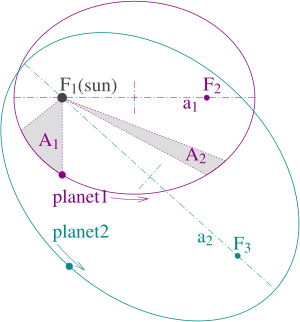Kepler's Laws facts for kids

(1) The orbits are ellipses, with focal points ƒ1 and ƒ2 for the first planet and ƒ1 and ƒ3 for the second planet. The Sun is placed in focal point ƒ1.
(2) The two shaded sectors A1 and A2 have the same surface area and the time for planet 1 to cover segment A1 is equal to the time to cover segment A2.
(3) The total orbit times for planet 1 and planet 2 have a ratio a13/2 : a23/2
Johannes Kepler found these laws, between 1609 and 1619. Kepler's laws of planetary motion are three laws that describe the motion of planets around the sun:
- Planets move around the sun in ellliptic orbits. The sun is in one of the two foci of the orbit.
- A line segment joining a planet and the Sun sweeps out equal areas during equal intervals of time.
- The square of the orbital period of a planet is proportional to the cube of the semi-major axis of its orbit.
Most planetary orbits are nearly circular, and careful observation and calculation are required in order to establish that they are not perfectly circular. Calculations of the orbit of Mars indicated an elliptical orbit. From this, Johannes Kepler concluded that other bodies in the Solar System, including those farther away from the Sun, also have elliptical orbits.
Kepler's work (published between 1609 and 1619) improved the heliocentric theory of Nicolaus Copernicus, explaining how the planets' speeds varied, and using elliptical orbits rather than circular orbits with epicycles.
Isaac Newton showed in 1687 that relationships like Kepler's would apply in the Solar System to a good approximation, as a consequence of his own laws of motion and law of universal gravitation.
Images for kids
See also
 In Spanish: Leyes de Kepler para niños
In Spanish: Leyes de Kepler para niños


